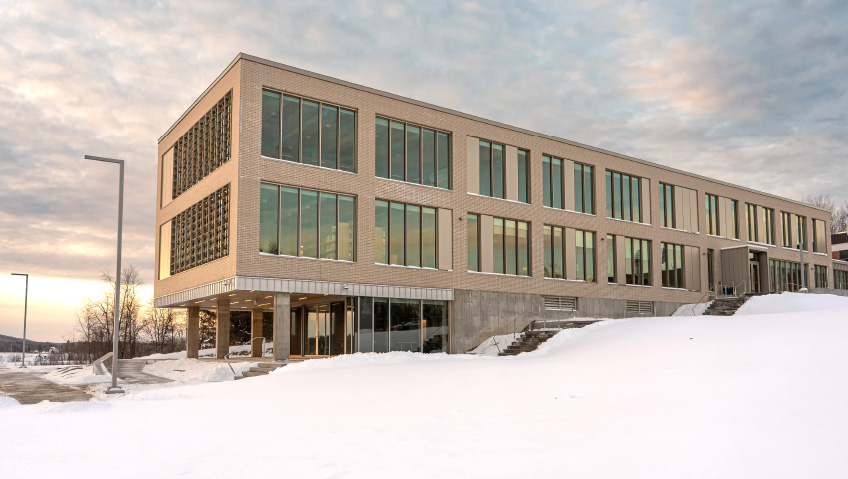Canadian custom millwork shop CCW Inc. has seen some very interesting developments in the span of just a year. Since we previously spoke in spring 2024, both Paul Martin and Jordan Howe have joined the CCW team as Operations Manager and Project Development Manager, respectively. This is part of an overall newly structured management team that the company has developed, and the additions of Martin and Howe have added skill sets in enterprise resource planning (ERP) and operations. The move is making the communications process more efficient.
Martin and Howe are also part of a new middle management line to the leadership structure, which acts as a filter for the vision of upper management—like Vice President Ian Scanling—funnelling that vision down to the various production teams so that innovative ideas and day-to-day workload can be better balanced.
For CCW, continuous improvement of its processes remains a significant focus. For instance, the team recently identified that it was lacking in the areas of effective communication and using the technology tools at its disposal (i.e. Microsoft Office and energyERP suites). This deficiency led to an environment wherein the stresses of growth were taking a toll on the company’s leaders, who were stretching themselves thin. Howe says that, with the new ERP skill set implementation, CCW has a lot of data that it is using to create key performance indicators or department scorecards, which are important in driving changes to existing processes.
The ability to make data-driven decisions is already a major factor in making decisions around which company processes need improvement. Thanks to these recent improvements, CCW is now able to find out the cost of an open job at any moment during its process and make timely decisions in response. This is critical in both process improvement and keeping the company agile in its marketplace. “It’s not gut decisions,” says Howe. “It’s data-based decisions for us.”
Martin explains that another ongoing process improvement is in the area of accountability, with very detailed records of who is responsible for what within the internal processes of the businesses. This begins with accountability charts and the establishment of defined rules, then looking at the root cause of a problem, gathering information, finding out where processes can be adjusted, and filling in the gaps to prevent the same mistake from happening again.
For example, Howe says, CCW deals with a lot of metallic laminates because it provides a valued product to customers; however, working with these laminates on the shop floor can be challenging because they damage easily and require a specific skill set to work with. In tracking the company’s work requisitions on damaged product coming through the shop, detailed lists can be populated of incidents on the shop floor and how products like laminates can be damaged. From there, leadership moves into meetings to ensure these products move through the shop in an effective manner, with attention paid to their specific handling so as to create a robust process and workflow.
With regard to general product quality, Martin says that the company’s finishing processes—particularly staining—have been modified to include a number of quality checks prior to sealing and top coating to achieve consistent colouring. This may involve laying out the entire project to make sure the colour matches or using practice panels prior to production. Every project involves a multi-step verification when it is assembled, prior to subsequent disassembly and packaging, and multiple people are part of this process to ensure correctness. In other departments, newer drawing technologies can allow for a faster turnaround for the CCW finishing department by increasing the team’s drawing capacities.
Howe says that, although CCW is most concerned with internal improvement, its current targets are not focused on expanding the company for growth’s sake but on increasing its overall bottom line. Its goals for the next three years are to build a strong business foundation that will be there when the company inevitably experiences another growth period, as well as ensuring that the right people and processes are present in the organization to take advantage of it. This will mean that CCW will never be overly reliant on a single person in a process. “Our bottom line will grow thanks to clear accountability and goals, so there are no more blurred lines for our workers,” Howe says.
CCW’s current direction is taking shape within a period of turmoil and uncertainty for many industries based in North America. Howe says that things in the industry have gotten a lot more competitive in terms of estimating, due in part to ongoing issues in the U.S. such as tariffs and the general political climate, both of which are affecting the company’s native Canada as well as the world at large. Many would-be clients are asking about prospective projects but are also holding back on turning them into anything tangible, as there is hesitancy around how things will turn out in the next two to three years, according to Howe.
Financial aspects like interest rates are also affecting businesses like CCW, again making it harder for prospective clients to start new projects. This is especially true in the condominium market because buyers are not purchasing in the same ways as they used to years ago; in this instance, condominium projects need to have sold around 60 to 80 percent to kick off a project, a figure not achievable due to the current circumstances.
During times like these, the company’s internal practices will continue to be a foundational part of its success. Martin says that CCW sports a truly great culture, one that the team will continue to strengthen by defining it through its values. These values will help the company grow and hire more great talent, as well as manage performance.
“A lot of foundational bricks for the next big growth spurt” are being laid, says Martin. Over the next year and change, CCW will be keeping its bottom line as its priority while looking at some changes to its plant layout and minor planned improvements with respect to modest capital investments. Martin says that the latter will be applied to improve automation as much as possible. The company is looking to build its engineering capacity and further develop its niche in unique products.
A big update that is nearing the end of the approval phase is CCW’s digital integration program, which will help the company go paperless while beefing up the provision of real-time information. The company is in the process of going after an Ontario Centre of Innovation grant that will help this project reach the next level. CCW is eager to make sure that, no matter where its clientele finds out about its expertise in architectural millwork, it will always be ready to follow up with its trademark unified approach.






